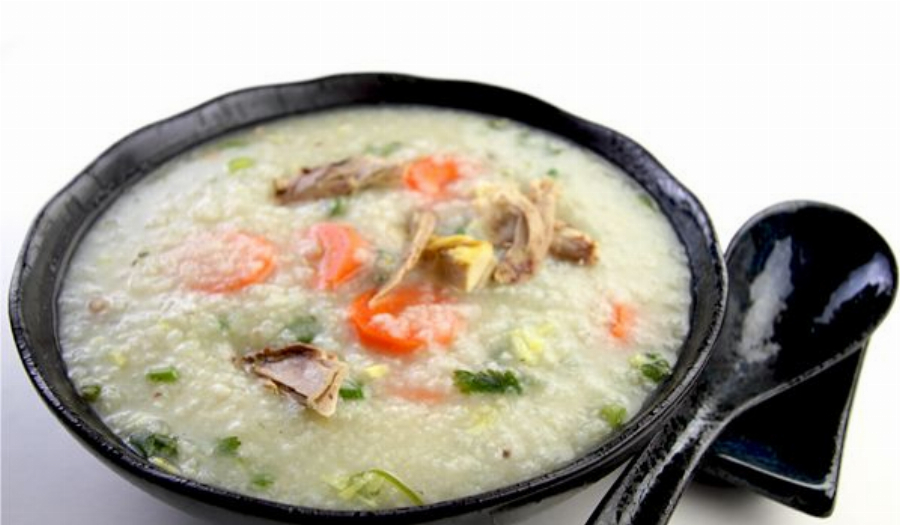The weather in the Bay Area wasn’t all that great over the weekend. It’s been rainy and very windy. Making rice soup seemed the appropriate recipe for this type of climate. If you’ve never had it, rice soup is a one-dish meal that is both filling and satisfying. You can add many different ingredients to your basic rice soup, but I made this particular version with my favorite meat: duck. It’s called cháo vịt in Vietnamese. I find duck meat to be a lot more flavorful than regular chicken.
Traditionally, it would be served with gơi vịt (Vietnamese duck salad using the remaining meat from the duck stock) and chopped bánh giò cháo quảy, which are Vietnamese savory beignets. I skipped the fried food to keep the meal healthy; I even took the time to strain and remove the extra fat floating at the top of the duck stock!
1. Info for Chao Vit Recipe (Vietnamese Duck Rice Soup)
- Cook Time: 40 mins
- Total Time: 1hr 20mins
- Servings: 8
- Calories: 350kcal
2. Ingredients for Chao Vit Recipe (Vietnamese Duck Rice Soup)
- 1 (3-½-pound) whole duck
- 2 chicken carcasses
- 1 (3-inch) chunk fresh ginger
- 2 yellow onions
- 2 tablespoons canola oil
- 1 carrot, trimmed and peeled
- 1 daikon radish, trimmed and peeled
- 4 teaspoons mushroom seasoning salt (or regular salt)
- 1 (about 1 ounce) chunk rock sugar, or (2 teaspoons granulated sugar)
- 2 cups Thai jasmine rice (see tips)
- 2 tablespoons green onions, thinly sliced
- 3 tablespoons cilantro, finely chopped
- 1-½ teaspoons black pepper, freshly cracked
3. Directions:
- Prepping the ginger: Cut the ginger root in half. Peel it with a paring knife, thinly slice it, then cut into long matchsticks. Finely chop. Set aside. Crush and bruise the other piece with the back of a Chef’s knife (or a meat hammer).
- Parboiling the poultry: Wash the chicken carcasses and whole duck. This step is important to get clear stock before starting the long, slow cooking. Fill a large stockpot with cold water (enough to cover the poultry). Bring to a boil. Add the whole duck and chicken carcasses. Bring the liquid back to a gentle boil, then lower the heat to a bubbly simmer for 3 minutes. Skim the impurities rising to the surface of the stock using a fine mesh strainer and set the duck, the carcasses and 2 quarts of skimmed liquid aside.
- Prepping the onions: Peel one whole yellow onion without cutting the stem to make sure the onion doesn’t fall apart in the stock. Slice the remaining onion. Heat the oil in a pan. Fry the onion, stirring frequently to prevent it from burning, until the color is evenly golden brown. Transfer to a plate, leaving as much oil as possible in the pan (save the oil).
- Making duck stock: Place the peeled onion, 2 quarts of the reserved strained liquid, the bruised ginger root, caramelized onions, carrot and daikon radish. Bring the liquid to a boil. Add the whole duck and chicken carcasses to the stock. Cook for about 15 minutes. Remove the whole duck from the pot. Let it cool a bit until you can handle it without discomfort. Make several deep diagonal incisions throughout the bird’s flesh. Place the duck back in the stock. Season with 2 teaspoons seasoning salt. Bring to a boil again and cook for another 5 minutes (cook the duck no more than 20 minutes).
- Remove the whole duck again from the stock. Let cool a bit. Debone and shred the meat. Set the meat aside on a platter. Return the duck bones and skin to the pot. Lower the heat under the pot to a bubbly simmer. Cook for about 1 hour. Regularly skim the impurities rising to the surface of the stock using a fine mesh strainer. Season with mushroom seasoning salt, rock sugar and black pepper. Cook for another 30-45 minutes. Let cool to room temperature.
- Fish out the carrot and daikon using a slotted spoon; transfer to a cutting board. Cut into thick slices and set aside.
- Strain the stock, plastic-wrap the pot tightly and place the whole pot in the refrigerator (optional). The fat from the stock may pick up some other odors from the refrigerator if the container is not sealed properly. A layer of fat will form at the surface, which can be easily removed, using a spoon. You can skip this step by regularly degreasing as the stock cooks using a fine mesh strainer. The stock is ready. You’ll need 2 quart of the stock.
- Note: The key to a successful outcome is to prepare the bowls individually (no more than 2 servings at a time).
- Wash and rinse the jasmine rice thoroughly in several water baths. Unlike basmati rice, no soaking time is needed. Drain as much water as possible.
- Heat the onion-flavored oil in a non-stick, medium saucepan. Add ½ cup rice to the saucepan. The oil should coat all the grains. Add 2 cups of boiling-hot duck stock and stir occasionally. Immediately lower the heat to a gentle boil. Cook until the stock thickens like porridge (the grains should burst a little). Add the carrot and daikon slices and the very finely chopped ginger. Cook for 5 more minutes. Stir in the shredded meat, green onions and cilantro. Depending on the consistency you like, you could add more stock to thin out the soup (optional: I didn’t add any). Adjust seasoning with salt and pepper.
- Serve immediately and call each person as their bowl of soup is ready. (You could also start 2 saucepans at a time).
- Repeat the same procedure for the next servings.

